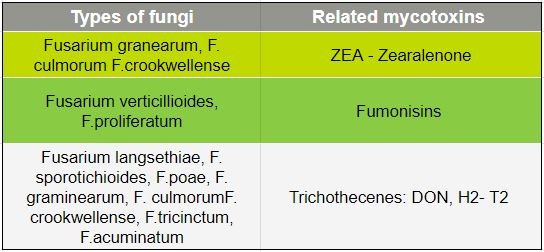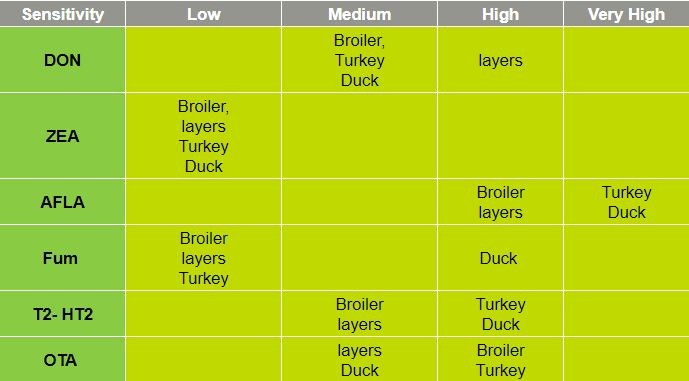Mycotoxins are a genuine threat to poultry production due to their unpredictable presence, which makes them difficult to detect. Mycotoxins currently contaminate more than 80% of cereal crops, sometimes even up to 100%. Cereal byproducts and raw material used in animal feed are also subject to contamination in any part of the world. The effects of mycotoxin are especially acute after they are ingested by animals. So how can we prevent poultry feed from mycotoxin contamination?
Field and storage mycotoxins
Mycotoxins that form before harvest are called field mycotoxins. Field mycotoxins are usually secreted by fungi on cereals and other crops. As cereals grow in fields, some climates and technical methods are especially likely to lead to the emergence of these mycotoxins. A simplified tillage or a corn that appears before wheat are among these risk factors.

Storage mycotoxins develop after harvest. Their presence is favored by moisture on cereals, by a mix of moist grains with dry ones or when the difference between the temperature levels within the silos where grains are stored is too high. Although these two categories of mycotoxins differ with regards to the period when they appear, both are just as dangerous for animals' health. They can have severe effects on animals' health in cases of high levels of contamination. More minor instances of contamination are more insidious in their effects, which are generally manifested by an overall decrease in performance.

Performance declines by species
As mammals, poultry species are more vulnerable to mycotoxins. Different species of chicken (chicken, turkey, duck, laying...) vary in their level of vulnerability to different kinds of mycotoxin. Chronic exposure at low doses causes reduced performance: from 0.2 ppm for T2 toxins for 3 weeks in chickens, a sharp decline in growth and a deterioration of ratios can be noticed. As for duck flocks, they can reach over 50% mortality with 4 ppm of T2 for 7 weeks. In the case of laying hen and broiler breeders, the impact is just as serious: exposure to more than 1 ppm of T2 can result in a sharp drop in egg production and increase the rate of infertile eggs. Exposure at higher doses results in problems for the reproductive organs, liver, kidney, heart, and other organs.
Mycotoxins also have carcinogenic effects (they can lead to the development of cancer), are mutagenic (they may alter the structure of the DNA gene) and are immunosuppressants (they reduce immune reactions).

How to limit the presence of mycotoxins in poultry feed?
Risks associated with the presence of mycotoxins require that raw materials and feed be submitted to stricter control. However, it is difficult to determine the exact amount of mycotoxins contained in a batch of raw materials since they are usually not evenly spread out throughout the batch. Furthermore, it is complex to submit feeds to thorough analysis. A sampling must therefore be undertaken based on best practices and using an appropriate procedure for analysis.
Multi-detection analysis are often recommended since several mycotoxins can be present within the same feed, interacting in ways that compound the overall toxicity: a feed that is contaminated both in toxin-DON and T2 is more toxic than one would expect from simply adding together the separate effects of each toxin.
Once the mycotoxin content is known, one must ensure that the levels are below the thresholds that have been set by local regulations and technical recommendations. Based on a risk analysis, incorporation of contaminated batches in the feed must be limited, and its use prohibited for the most sensitive species.
In case of a confirmed presence of mycotoxins —poor quality harvest, large amounts of highly contaminated raw material, highly susceptible species — it is also possible to incorporate sensors directly within the feed.
To provide you with the best advice, our experts keep an updated register of the level of contamination of raw materials. Depending on the species, they will be able to inform you on the accepted tolerance levels and on actions to avoid reduced performance and economic losses. Should you want more information please do not hesitate to contact them!
Talk to our experts
Feedia embodies Techna's range of advice and solutions in breeding techniques and precision nutrition, serving the performance of production organisations, feed manufacturers and their breeder customers.
